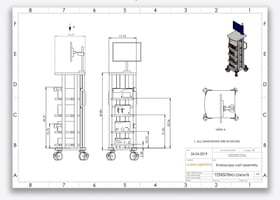Ready to make your products truly configurable with Tacton Works? You've landed in the perfect...
Unlocking the Power of Tacton’s Product Configurator for CPQ Efficiency
Getting a complex product to market fast and without error is critical for manufacturers. But when products come with hundreds of customizable features, finding valid configurations while keeping everything in line with manufacturing and pricing constraints can be a huge challenge. This is where Tacton’s product configurator becomes invaluable. Built on a robust constraint solver, Tacton’s configurator handles product complexities at scale, ensuring the right configurations with minimal manual intervention.
In this blog post, we’ll explore the Tacton configurator’s structure, breaking down how it interprets product models, tackles constraint satisfaction, and optimizes solutions. For those working in manufacturing, understanding these capabilities can help you maximize CPQ (Configure, Price, Quote) efficiency and deliver an exceptional experience to your customers.
Configuration Models: The Foundation of Tacton CPQ
Every product configuration begins with a model, which serves as the blueprint for creating variations. In Tacton CPQ, configuration models define the entire structure and set of features of a product, dictating how customers can interact with the product configuration process. Tacton supports two primary model types—Product Modeling and TCX Configuration Modeling. Both types are translated into an internal representation used by the configurator for essential operations like attribute validation, configuration generation, and constraint enforcement.
Whether it's selecting crane components at HMF or managing unique lift setups at Swift Lifts, the configuration model streamlines complex product specifications into manageable selections. Tacton’s configurator converts these details into a language that allows for automated validation and user interaction, reducing the risk of errors and ensuring that the configured product is buildable.
Constraint Satisfaction Problems (CSP): The Core of Tacton’s Configurator
At the heart of Tacton’s configurator is a mathematical concept called Constraint Satisfaction Problem (CSP). In a CSP, the configurator manages a set of variables (representing different attributes or components) and assigns values within set ranges, known as domains, while adhering to specified constraints. The objective is to find a configuration where all constraints are satisfied, ensuring that any customer-selected features are valid together.
Simplifying CSP: An Example
Let’s imagine a simplified CSP for configuring a fictional product with two features, X and Y:
- X has possible values
{1, 2, 3, 4, 5} - Y has possible values
{1, 2, 3, 4, 5} - Constraints: X + Y > 6 and X * Y < 12.
The configurator would evaluate combinations until it finds valid solutions, such as X=2 and Y=5. If there’s no solution that meets all constraints, the configurator returns an error, prompting the user to modify selections. This process, though vastly more complex in real configurations, highlights how Tacton uses CSP to enforce valid and manufacturable product configurations automatically.
Translating Configuration Models into CSPs
To apply CSP principles to a real product, Tacton’s configurator first converts a configuration model into CSP elements. Each variable, such as a product feature or component attribute, gets an internal domain based on its allowed values. Tacton’s configurator also establishes constraints, which might be arithmetic or logical relationships between variables, based on the product rules set in the model.
For example, in a model with attributes like color, height, and weight:
- Variables: Attributes and feature values (e.g., “Red” for color).
- Domains: Possible values (e.g.,
{Red, Yellow, Blue}mapped to{1, 2, 3}internally). - Constraints: Mathematical or logical rules governing how attributes interact.
This transformation from configuration model to CSP allows Tacton’s configurator to treat even the most complex product setups as solvable mathematical problems. As a result, configurations are validated quickly and accurately, ensuring compatibility of selected options before moving to pricing and quoting.
Finding Solutions: Propagation and Search Techniques
One of the most impressive aspects of Tacton’s product configurator is its ability to find solutions using propagation and search methods. Let’s look at how each of these processes works and why they’re essential for complex product configurations.
Propagation: Streamlining Search Space
Propagation is the process of trimming down a variable’s domain by eliminating values that would lead to invalid configurations. For instance, if a constraint requires X + Y > 6, and X = 1, then values like {1, 2, 3, 4} might be removed from Y's domain since they don’t satisfy the constraint when paired with X = 1. By removing invalid options early, Tacton’s configurator reduces the number of potential configurations, making solution-finding more efficient.
Propagation is performed across each constraint in isolation. If a variable’s domain is reduced, constraints involving that variable are checked again until no further reductions are possible. At this point, if:
- Each variable has a single value: The configurator has found a solution.
- One domain is empty: No solution exists.
- Some domains have multiple values: The configurator must search further.
Search: Solving the CSP Step-by-Step
When propagation alone doesn’t resolve a configuration, Tacton’s configurator switches to search mode. Here, the configurator picks a variable with multiple values and tests each possibility against constraints. Much like finding an exit in a maze, the configurator backtracks if a chosen path (value) leads to a dead end (invalid configuration). This approach systematically explores options until it finds a valid solution or confirms that none exists.
Through a combination of propagation and search, Tacton’s configurator handles complex configurations at scale, solving for the optimal solution while maintaining high performance.
Optimizing Configurations for Efficiency
For modelers and configuration specialists, knowing how to optimize configurations in Tacton can lead to faster, more efficient solution-finding. Here are a few key tips for efficient modeling:
- Constraint Simplification: Compact constraint formulations reduce the computational load. Equal constraints is always a good practice.
- Manual Domain Reduction: If a value is clearly invalid in a domain, remove it manually to save on propagation time.
- Heuristic Order: Prioritize variables with smaller domains and those heavily involved in constraints, as this can significantly improve search efficiency.
User Interaction and the Configuration Process
From a user’s perspective, Tacton’s configurator feels responsive, allowing users to make selections and see real-time updates. This interaction is achieved through transactions, where each action (e.g., selecting a color or component) triggers three phases:
- Load State: Retrieve the current model state, including cached data if available.
- Action Execution: Apply the requested change, such as selecting a feature or verifying constraints.
- Result Generation: Produce the response, typically displaying the valid configuration.
For modelers, keeping configurations “light” by limiting visible fields and simplifying attribute selections can enhance transaction speeds.
Efficient Domain Validation for Seamless Interaction
Domain validation—ensuring each attribute value can lead to a valid configuration—is typically where the configurator spends most of its processing time. To improve this, keep visible fields minimal and prioritize “free” input options over drop-downs or checkboxes. This approach minimizes validation checks, reducing the time needed for each configuration choice.
For TCX models, advanced settings like strong_propagation_only allow for quick validation, ensuring only possible values are considered without exhaustive testing. These optimizations create a smoother user experience while reducing computational demands on the configurator.
Tacton’s product configurator isn’t just a tool—it’s the backbone of an efficient CPQ system that can handle the most intricate configurations with ease. By transforming complex product models into solvable CSPs and using optimized propagation and search techniques, Tacton enables companies to deliver precisely configured products faster and with fewer errors.
For those working with Tacton, understanding these capabilities and incorporating best practices into your models can make a significant difference in CPQ performance. By refining constraints, focusing on efficient domain management, and simplifying user interaction, you can maximize the power of Tacton’s configurator, providing an edge in both speed and accuracy.
For more on how Tacton’s configurator can transform your CPQ process, contact our team at cpq.se or book a virtual coffee chat with Magnus or Patrik to discuss your specific needs. Let’s explore how you can achieve seamless configurations and take your product offerings to the next level.




